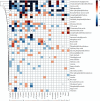Metabolomics and Lipidomics Studies in Pediatric Type 1 Diabetes: Biomarker Discovery for the Early Diagnosis and Prognosis
- PMID: 40303249
- PMCID: PMC12016713
- DOI: 10.1155/2023/6003102
Metabolomics and Lipidomics Studies in Pediatric Type 1 Diabetes: Biomarker Discovery for the Early Diagnosis and Prognosis
Abstract
Aim: Type 1 diabetes (T1D) is an autoimmune disease with heterogeneous risk factors. Metabolic perturbations in the pathogenesis of the disease are remarkable to illuminate the interaction between genetic and environmental factors and how islet immunity and overt diabetes develop. This review aimed to integrate the metabolic changes of T1D to identify potential biomarkers for predicting disease progression based on recent metabolomics and lipidomics studies with parallel methodologies.
Methods: A total of 18 metabolomics and lipidomics studies of childhood T1D during the last 15 years were reviewed. The metabolic fingerprints consisting of 41 lipids and/or metabolite classes of subjects with islet autoantibodies, progressors of T1D, and T1D children were mapped in four-time dimensions based on a tentative effect-score rule.
Results: From birth, high-risk T1D subjects had decreased unsaturated triacylglycerols, unsaturated phosphatidylcholines (PCs), sphingomyelins (SMs), amino acids, and metabolites in the tricarboxylic acid (TCA) cycle. On the contrary, lysophosphatidylcholines (LPCs) and monosaccharides increased. And LPCs and branched-chain amino acids (BCAAs) were elevated before the appearance of islet autoantibodies but were lowered after seroconversion. Choline-related lipids (including PCs, SMs, and LPCs), BCAAs, and metabolites involved in the TCA cycle were identified as consensus biomarkers potentially predicting the development of islet autoimmunity and T1D. Decreased LPCs and amino acids indicated poor glycemic control of T1D, while elevated lysophosphatidylethanolamines and saturated PCs implied good glycemic control. Further pathway analysis revealed that biosynthesis of aminoacyl-tRNA, BCAAs, and alanine, aspartate, and glutamate metabolism were significantly enriched. Moreover, established cohort studies and predictive statistical models of pediatric T1D were also summarized.
Conclusion: The metabolic profile of high-risk T1D subjects and patients demonstrated significant changes compared with healthy controls. This integrated analysis provides a comprehensive overview of metabolic features and potential biomarkers in the pathogenesis and progression of T1D.
Copyright © 2023 Yaru Liu et al.
Conflict of interest statement
The authors declare that they have no conflicts of interest.
Figures




Similar articles
-
Dynamics of Plasma Lipidome in Progression to Islet Autoimmunity and Type 1 Diabetes - Type 1 Diabetes Prediction and Prevention Study (DIPP).Sci Rep. 2018 Jul 13;8(1):10635. doi: 10.1038/s41598-018-28907-8. Sci Rep. 2018. PMID: 30006587 Free PMC article.
-
Parallel Multi-Omics in High-Risk Subjects for the Identification of Integrated Biomarker Signatures of Type 1 Diabetes.Biomolecules. 2021 Mar 4;11(3):383. doi: 10.3390/biom11030383. Biomolecules. 2021. PMID: 33806609 Free PMC article.
-
Characterization of plasma lipidomics in adolescent subjects with increased risk for type 1 diabetes in the DiPiS cohort.Metabolomics. 2020 Oct 8;16(10):109. doi: 10.1007/s11306-020-01730-x. Metabolomics. 2020. PMID: 33033923 Free PMC article.
-
Modeling strategies to study metabolic pathways in progression to type 1 diabetes--Challenges and opportunities.Arch Biochem Biophys. 2016 Jan 1;589:131-7. doi: 10.1016/j.abb.2015.08.011. Epub 2015 Aug 24. Arch Biochem Biophys. 2016. PMID: 26314918 Review.
-
Metabolomics in the studies of islet autoimmunity and type 1 diabetes.Rev Diabet Stud. 2012 Winter;9(4):236-47. doi: 10.1900/RDS.2012.9.236. Epub 2012 Dec 28. Rev Diabet Stud. 2012. PMID: 23804263 Free PMC article. Review.
References
Publication types
MeSH terms
Substances
LinkOut - more resources
Full Text Sources
Medical

